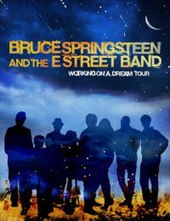| Tour by Bruce Springsteen and the E Street Band | |
 | |
| Location |
|
|---|---|
| Associated album | Working on a Dream |
| Start date | April 1, 2009 |
| End date | November 22, 2009 |
| Legs | 3 |
| No. of shows | 83 |
| Box office | $167 million[1] ($237.17 in 2023 dollars)[2] |
| Bruce Springsteen and the E Street Band concert chronology | |
The Working on a Dream Tour was a concert tour by Bruce Springsteen and the E Street Band, which began in April 2009 and ended in November 2009. It followed the late January 2009 release of the album Working on a Dream. This was the first full E Street Band tour without founding member Danny Federici, who died during the previous tour in 2008, and the final tour for founding member Clarence Clemons, who died in 2011.
The tour was shorter than a typical Springsteen outing, but for the first time in his career, it placed an emphasis on performing at music festivals, especially in Europe. Even more unlike all his previous tours, the Working on a Dream Tour featured little of his new album. Instead, several trends from the latter stages of the previous year's Magic Tour were carried forward: a focus on topical content, this time the late-2000s recession; a repetition of some of the stage raps and antics; and most visibly, continuation of a 'signs' segment, in which audience members would hold up signs requesting rare Springsteen songs or decades-past oldies and the band would stage (sometimes impromptu) performances of them. The final leg of the tour often featured another first as Springsteen played one of his classic 1970s or 1980s albums all the way through. Critical reaction to the tour's shows was generally positive, although the absence of the new material was noted.
Max Weinberg was not available for parts of the tour due to his bandleader obligations to The Tonight Show with Conan O'Brien, which was just commencing. His 18-year-old son, Jay Weinberg, became his replacement for parts or all of a number of shows, to a mostly positive reception from the rest of the band, the audience, and critics. The tour also gave Springsteen a chance to bid farewell to two famous venues he had played many shows at – the Philadelphia Spectrum and New Jersey's Giants Stadium.
The tour was a commercial success, grossing over $167 million, being seen by over 1.9 million ticket holders, and finishing as the third-highest-grossing tour in the world for 2009 even though the tour faced some logistical issues. Ticket sales were botched by Ticketmaster, a situation further exacerbated by revelations of their holding seats back for their secondary market TicketsNow. Before long, legislatures and attorneys general of several states, as well as members of the U.S. Congress and federal regulatory agencies, were weighing in on the matter, with various lawsuits, settlements, and proposed laws as the result.
- ^ Cite error: The named reference
bb-tour-25was invoked but never defined (see the help page). - ^ 1634–1699: McCusker, J. J. (1997). How Much Is That in Real Money? A Historical Price Index for Use as a Deflator of Money Values in the Economy of the United States: Addenda et Corrigenda (PDF). American Antiquarian Society. 1700–1799: McCusker, J. J. (1992). How Much Is That in Real Money? A Historical Price Index for Use as a Deflator of Money Values in the Economy of the United States (PDF). American Antiquarian Society. 1800–present: Federal Reserve Bank of Minneapolis. "Consumer Price Index (estimate) 1800–". Retrieved February 29, 2024.
